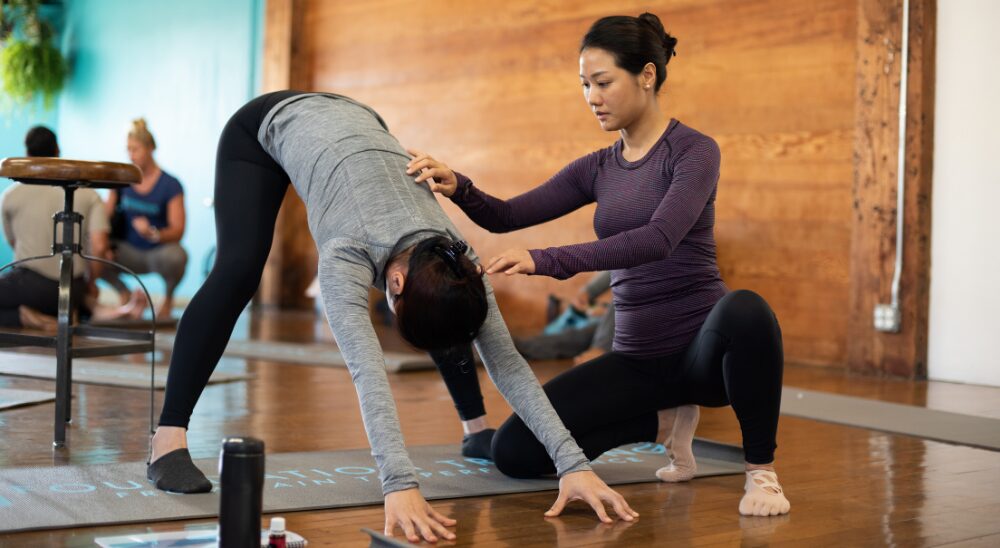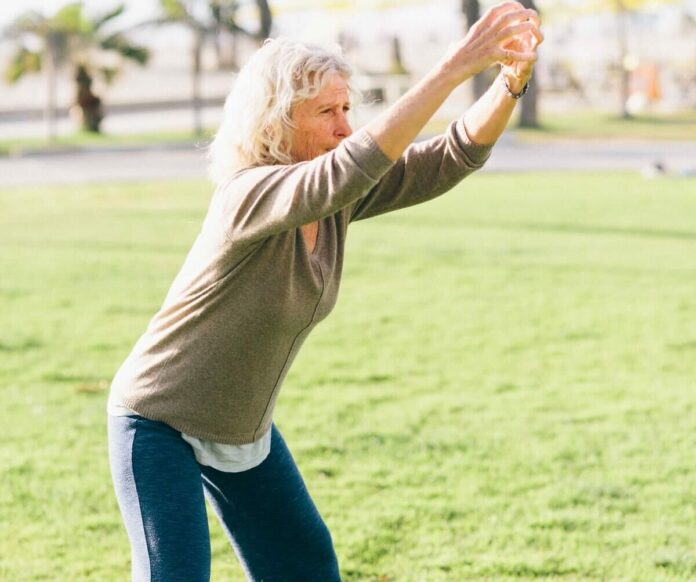While in his final year of chiropractic school in 2007, Dr. Eric Goodman was suffering from chronic back pain from an accident and was advised to have spinal fusion surgery by his traditional Western medicine doctors. As a chiropractic student, he wanted a non-surgical solution; so, he created Foundation Training. It worked for him and, as a result of his accident, he has helped thousands get relief from chronic pain.
Get super helpful articles like this for free with the award-winning best-in-class AGEIST weekly magazine here.

Dr. Goodman, please tell us a little about Foundation Training.
Foundation Training uses isometric poses, postures and breathing exercises to strengthen and lengthen the body’s core area by activating the posterior (back side) muscle chain and decompressing the torso.
Why does this help?
Most chronic pain that people feel isn’t because of a specific condition like sciatica. The issue is that we develop compensatory movement patterns throughout our life. In our program, we lift and expand the spine and torso to give more room for the nervous system and for the organs. We also lift everything inward to allow space in the back of the pelvis in order to retrain and re-pattern our movements. These poses anchor and decompress the spine and torso and this takes pressure off of the joints and that is what provides relief. The relief can be extraordinary.
AGEIST has published an article about one of your favorite clients, Patti Sheaff.
Yes, Patti found relief using Foundation Training as described in the AGEIST article, “Foundation Training: What Does It Do for You?” Patti is one of my favorite clients because she was fragile when I first started working with her, but she would not give up even if she hit an obstacle. Patti was an experienced surfer and snowboarder. However, accumulated sports injuries, along with a work injury, nearly put an end to Patti’s active lifestyle at age 62. In her words, “I was in serious pain for a while and had to stop surfing for a year.” What she didn’t say was that she hadn’t been able to take pain killers to address her pain.
Get super helpful articles like this for free with the award-winning best-in-class AGEIST weekly magazine here.
Patti found one of my books and started practicing the techniques. Foundation Training enabled her to continue to train and do the things she loves to do. It worked so well for her that she became a practitioner so she could help others get non-surgical relief from chronic pain.
What are the specific goals of your program?
The program is designed with the goal of restoring stability, confidence, and counterbalance for participants.
Can you please elaborate on this goal and what do you mean by counterbalance?
We want to help people who want to get healthier and stronger and give them an easy pathway to get there. Many of the poses utilize a hip hinge that pushes the butt back and lifts the arms forward. This is nature’s counterbalance. Counterbalance is fundamental to human movement, and when it is lost, our muscles lose the ability to protect our joints. This is why we want to restore degraded counterbalance.

What is the scope of your program?
The overall aim of the program is to provide a practical, everyday routine that can lead to improved wellbeing and strength within three to six months of consistent practice.
Who are your ideal candidates for Foundation Training with Dr. Goodman?
I like using examples to answer this question. Besides Patti, I love to talk about another client who I met when he was in his late 80s. He was still working and full of energy and wanted to surf again but could not because of chronic pain. Once he started using Foundation Training, he resumed surfing shortly thereafter. He inspired many people as he trained alongside other surfers 30 and even 50 years younger than him.
My father is also using the program. He was going to have a procedure to remove a bone in his foot. So we started doing walking drills, going slightly uphill and downhill. Initially, it was difficult for him to apply rotation to his hips but, in a very short time, he improved and was able to avoid the surgery, even to this day.
What does the program promise for the sufferer of chronic pain?
The program does not promise to turn back the clock but aims to help participants become stronger and more confident versions of themselves after three to six months of performing the program.
To some people, three to six months might seem like a long time to get results. What are some short-term improvements or feedback the participants can expect to achieve?
Most people feel incremental improvements right away. Significant improvements are seen in three to six months.
Get super helpful articles like this for free with the award-winning best-in-class AGEIST weekly magazine here.
You have a program designed for those 65 and over. Is the 65+ program a “simplified” version of the Dr. Goodman main program?
The goal and the workouts are the same but the entry points are easier. For example, one of the exercises, the “step backs,” is a counterbalance exercise and we utilize a broom handle or similar prop to make it easier for the patient to do. Usually, the adaptation period is quick and often the props are no longer needed.
How did the 65+ come about?
Many younger patients asked for the 65+ program because they wanted their parents to do a similar program.
How would you recommend someone start and progress into Dr. Goodman’s program?
There are several groups of exercises with several videos of each:
- Balance Drills & Routines
- Posture Drills & Routines
- Mobility Drills & Routines
- Seated Drills & Routines
- Ground Drills & Routines
Any of these can be a starting point. For example, if someone has balance issues, they should start with the balance drills and routines.
I suggest that people start slowly. Don’t do the exercises like a workout where you think you need to destroy yourself. There is no need to rush through the material or the moves. Frequency is key. I recommend five to seven times per week with a minimum of ten minutes per session. In those ten minutes you will learn to become aware of what the exercises are intending to do.
Do the movements in front of a mirror. Do them with someone else who can provide feedback to make sure the movements are done correctly. We also have over 1400 certified instructors who, of course, are happy to help.
Dr. Goodman, it was a pleasure to discuss your program with you.
Thank you for the opportunity for me to share Foundation Training with you and the AGEIST audience.
For more information about Foundation Training, the 65+ program, or to find an instructor, please visit www.foundationtraining.com.
Written by Greg Damian: I am a 61-year-old author, motivational speaker, health and fitness disruptor and an Elite coach. My mission is to assist men over 50 to overcome perceived limits of their age to look and feel younger. My book, Abs at 60: The Four Steps to Look and Feel Younger at Any Age is available on Amazon. Each chapter of the book has a set of questions to answer. You can download a free workbook that includes all of these questions at www.absat60.com. At my website you can also learn about my Elite coaching services. I will donate 50% of my coaching revenue to a charity of your choice, if you meet your goals.
Get super helpful articles like this for free with the award-winning best-in-class AGEIST weekly magazine here.




Years ago when I was suffering from a chronic injury (back and hip), I worked with a trainer in Toronto who gave me a couple of Foundational Training coaching sessions. The relief was immediate and a Godsend.